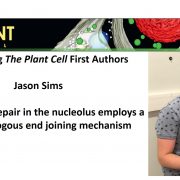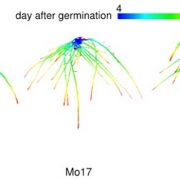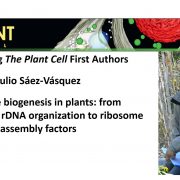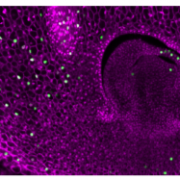
Recognizing Plant Cell first authors: Jason Sims
The Plant Cell, The Plant Cell: Author ProfilesJason Sims, first author of Meiotic DNA repair in the nucleolus employs a non-homologous end joining mechanism
Current Position: Post-doctoral researcher at the University of Vienna / MFPL
Education: PhD in molecular biology, special doctoral program in Chromosome Dynamics, from the University of…

Scaffolding Brassinosteroid Components to Improve Plant Growth
Research, The Plant Cell, The Plant Cell: In a NutshellAmorim-Silva et al. identify scaffolding proteins that optimize BR signaling. Plant Cell https://doi.org/10.1105/tpc.19.00150
By Vitor Amorim-Silva and Miguel Botella
Background: The plant hormone Brassinosteroid (BR) is essential for proper growth. This hormone is extracellularly perceived…

Mediator Skills: MED16 Controls Endoreduplication
Research, The Plant Cell, The Plant Cell: In BriefThe discovery of Mediator began with the observation that two transcriptional activators could interfere with each other’s function in vitro, even though they did not bind to the same promoter (Kelleher, Flanagan and Kornberg, 1990). The hypothesis, since then well-validated, was that each transcription…

Local and Global Root Growth Dynamics in Maize
Research, The Plant Cell, The Plant Cell: In a NutshellJiang et al. use time-lapse 3D imaging, computer vision, and mathematical modeling to quantify root system architecture. Plant Cell https://doi.org/10.1105/tpc.19.00015
By Ni Jiang and Christopher Topp, Donald Danforth Plant Science Center
Background: Root systems are the literal foundations…

Recognizing Plant Cell first authors: Julio Sáez-Vásquez
The Plant Cell, The Plant Cell: Author ProfilesJulio Sáez-Vásquez, first author of Ribosome biogenesis in plants: from functional 45S rDNA organization to ribosome assembly factors
Current Position: CNRS Researcher (DR2), LGDP UMR5096 CNRS-UPVD
Education: PhD Université de Perpignan (UPVD), France
Non-scientific Interests: Music, biking…

Setting Time for a Hot Date: Paused Embryo Development and Protective Organogenesis Allow Dates to Cope with the Desert Environment
Research, The Plant Cell, The Plant Cell: In BriefAdaptive developmental plasticity, in which changing environmental conditions modulate morphogenesis, can help organisms survive harsh conditions. Common examples include the protection of shoot apical meristems by transient arrest and sequestration into bud-like structures in wintering evergreens (e.g.…

Recognizing Plant Cell first authors: Jingjing Cao
The Plant Cell, The Plant Cell: Author ProfilesJingjing Cao, co-first author of Evolutionary metabolomics identifies significant metabolic divergence between maize and its wild ancestor, teosinte
Current Position: Assistant researcher at Institute of Plant Protection, Jiangsu Academy of Agricultural Sciences, China
Education: PhD in Botany,…

Recognizing Plant Cell first authors: Guanghui Xu
The Plant Cell, The Plant Cell: Author ProfilesGuanghui Xu, c0-first author of Evolutionary metabolomics identifies significant metabolic divergence between maize and its wild ancestor, teosinte
Current Position: Ph.D. student at China Agricultural University
Education:
Ph.D. candidate in Plant Genetics and Breeding, China Agricultural University
Master’s…

Self-assembling organelles for CO2 fixation: stoichiometry and structural plasticity
Research, The Plant Cell, The Plant Cell: In a NutshellSun et al. investigate how carboxysomes are constructed and regulated in cyanobacteria. Plant Cell https://doi.org/10.1105/tpc.18.00787
By Luning Liu
Background: All cells are composed of well-defined compartments to encase enzymes and reactions to increase the efficiency of biological processes.…

